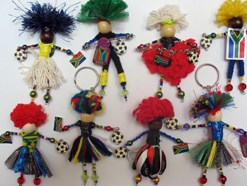Leaving a social legacy

The creators of the handmade "SA Soccer Dollies" have succeeded in benefitting from the World Cup hype. Photo (c) www.elolo.com
02.06.2010
By Miko SchneiderWe ask ourselves whether the country will be left with crippling debt and ‘white elephant’ stadia, or whether the spending on our cities’ infrastructure, the boost in tourism, and the (hopefully) positive light shed on our country will outweigh these costs.
Another way to measure the legacy of the 2010 World Cup will be to assess whether international attention has benefitted local football, or whether there has been a boost in exposure and funding for upliftment projects, in the name of social responsibility surrounding the event.
Governmental and official initiatives
The South African government and the World Cup Local Organising Committee (LOC) 2010 have a number of encouraging projects running concurrently to the main event. These include the Football Turf Programme, where the LOC has dedicated approximately €8m to build new turfs in each of the 52 South African Football Association regions. The money will also go to clubhouse facilities, security and training of maintenance staff.
1Goal: Education for All is an education campaign to provide schooling for 75 million children, half of whom live in Africa. The impetus for the project was the idea that the World Cup legacy should include education for the continent, and the tournament has provided a platform for the South African government to promote the project to world leaders and mobilise their support.
Yet another initiative, Win in Africa with Africa, includes training African football executives, improving community health programmes, and developing national leagues. FIFA set aside approximately €57m for this project.
Corporate sponsorships in local football
The trend in local football is a substantial revenue boost from corporate sponsorship. The PSL signed a deal with banking giant ABSA for over €50m from 2007-2012; as well as a €160m broadcast deal with local pay/satellite broadcaster Supersport. This means that, as of 2008, the PSL was ranked the league with the seventh largest sponsorship revenue worldwide.
Only time will tell whether an improvement in financial means will see a real improvement in local football standards, or whether the sponsorship boom will outlast the hype. Sports journalist and World Cup commentator, Justin Zehmke, says, “As for the local league, it received a huge cash injection thanks to the attention focused by [the World Cup]... Again, there are very real fears that, once the attention moves on, this may dry up.”
Private and non-governmental initiatives
In addition to official and government initiatives, a number of private and non-governmental organizations are getting behind local upliftment as a result of World Cup mania, for example by establishing soccer clinics where professional clubs team up with school children in their areas to share their skills. Job creation schemes are also hoping to improve the quality of life for many talented, yet previously unemployed, South Africans.
Elolo in Cape Town is a company producing hand-made ‘SA Soccer Dollies’. The creators come from the Mfuleni township community near Cape Town, and are affected by HIV/AIDS. The money they have earned from producing the dolls has gone towards drastically improving their living conditions.
A similar success story is Johannesburg start-up Newton Projects, a company that is able to mass-cut makarapa miners’ hats worn by fans in the stadia, while employing 40-50 local street artists to paint them with unique and colourful designs. Not only do the makarapas provide an income for these artists, but they are also given a sense of pride to see their work worn by thousands of supporters, and displayed in the media. Once the football World Cup is over, the business will turn to other sports for inspiration.
The number of social projects out there is a promising reflection on the rallying potential of the world’s biggest sporting event. The social legacy of the 2010 World Cup has a strong basis upon which to flourish.





